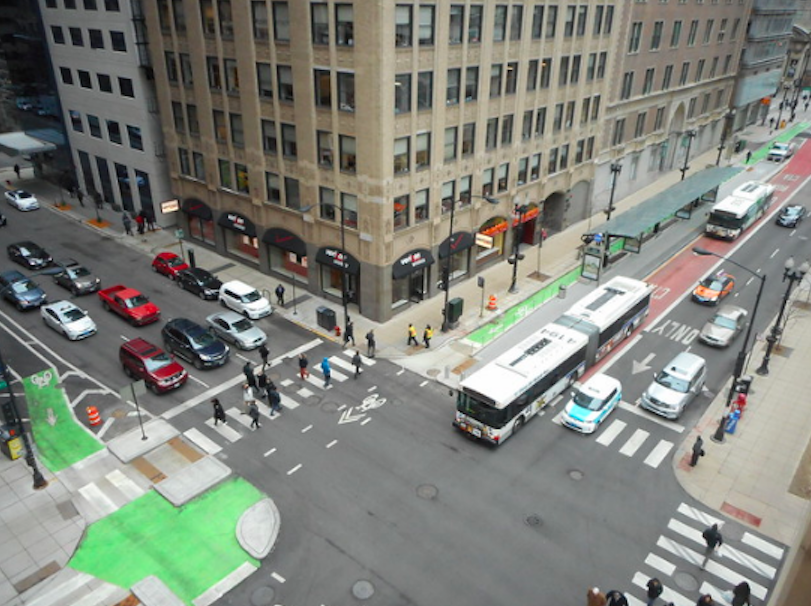This op-ed originally ran in Crain's magazine.
Chicago’s fundamental transportation problem is too many cars.
The excess of driving puts people in danger, with 121 traffic deaths in our city last year, disproportionately imperiling people walking and biking, who made up 46 percent of the victims.
It makes Chicago less just, since our auto-focused transportation system makes it more difficult for residents of lower-income black and brown communities that are rapid-transit deserts—from Altgeld Gardens to Belmont Cragin—to access job and education opportunities.
The increasing amount of driving in Chicago, fueled by the growing popularity of ride-hailing, is counterproductive to fighting climate crisis. Our city should be at the forefront of reducing emissions from transportation.
And, of course, car-generated congestion makes it harder for just about everyone to get where they need to go in a reasonable amount of time. The fact is, cars—large metal, multi-ton boxes that usually contain only one or two occupants—just aren’t a smart way to move lots of people around cities.
The good news is that Mayor Lori Lightfoot’s transportation platform already includes many of the solutions for reducing the number of cars on the road.
One of her key campaign pledges was to create more dedicated space on the streets for transit and cycling. That often involves converting mixed-traffic lanes to bus- and bike-only lanes.
Under the Rahm Emanuel administration, Chicago took some baby steps toward developing a rapid bus system, including the creation of the Jeffery Jump and Loop Link express routes. But we’ve still only got only about 4 miles of dedicated bus lanes, way fewer than cities like San Francisco (27 miles), Los Angeles (35.4), and New York (82.8). As such, Lightfoot set a goal of building 50 miles of bus lanes to keep straphangers from getting stuck in car traffic.
Of course, bus lanes are useless if they’re clogged with unauthorized vehicles, and lax enforcement of the red Loop Link lanes is a factor in why the corridor has only seen modest bus speed improvements. So we’re glad Lightfoot promised to work with state legislators to legalize fair camera enforcement of bus lanes.
Another way to improve transit service would be to reduce the number of ride-hailing vehicles on the road, which not only cannibalize CTA ridership but also make traffic worse, since Uber and Lyft drivers spend much of their time “deadheading” with no passengers. Lightfoot committed to add a surcharge for ride-hailing trips that begin in the congested, transit-rich Loop, as well as to implement a fee for ride-hailing vehicles that operate within Chicago but are registered elsewhere, and use the revenue to fund bus lane construction and increased 24-hour CTA service.
Like faster transit, safer bicycling can help reduce car trips. It’s likely that many “interested-but-concerned” types would try bike commuting if they had some assurance that they wouldn’t be struck by drivers. So the dozens of miles of physically protected bike lanes installed under Emanuel, sheltered from traffic by concrete curbs or parked cars, were a major upgrade. Lightfoot promised to pick up the pace of protected bike lane installation by earmarking $20 million a year in the city’s budget for cycling and walking safety infrastructure.
Divvy is currently expanding citywide, adding 10,500 new cycles with an electric-assist motor (helpful for getting around less-dense parts of the South and West sides), with built-in locks that will allow them to be parked anywhere, not just at docking stations. That will help close some gaps in the transportation network, but, again, we can’t just drop off bikes in areas with no safe bike infrastructure and expect people to ride them, so building more protected lanes will be key.
Chicago is currently testing dockless electric scooters on the West and Northwest sides, with a 2,500-vehicle pilot that runs through Oct. 15. These gadgets can also potentially help residents in transit deserts, but so far their safety record is not great, with at least 34 reported scooter-related emergency room visits in the first five weeks of the program. So the Lightfoot administration should analyze the trip and crash data carefully. But scooters do have the potential to build more political support for building car-free protected lanes—ideally, every major street would have dedicated space for bikes and scooters, as well as bus lanes.
Fortunately, Lightfoot is on the right page when it comes to reducing the number of cars in Chicago—we just need to make sure she keeps her word.



